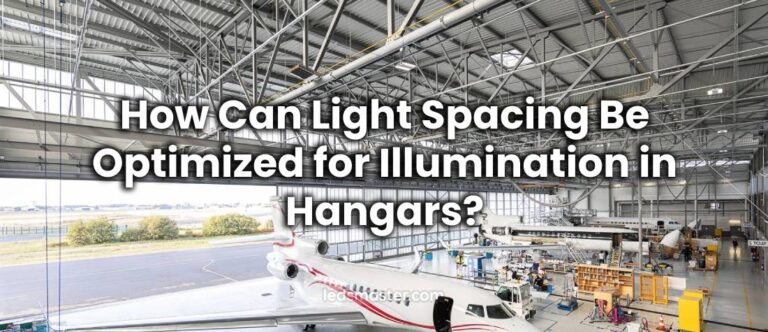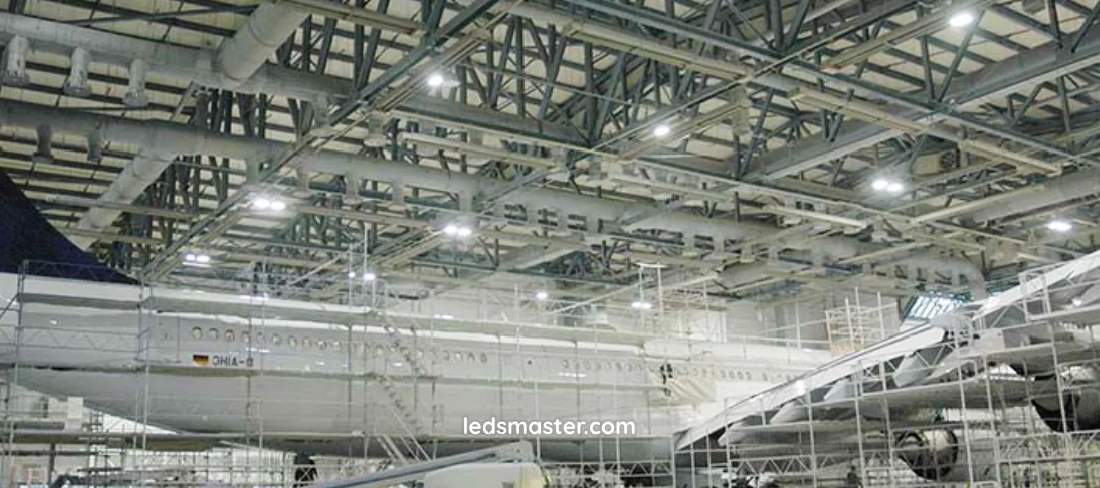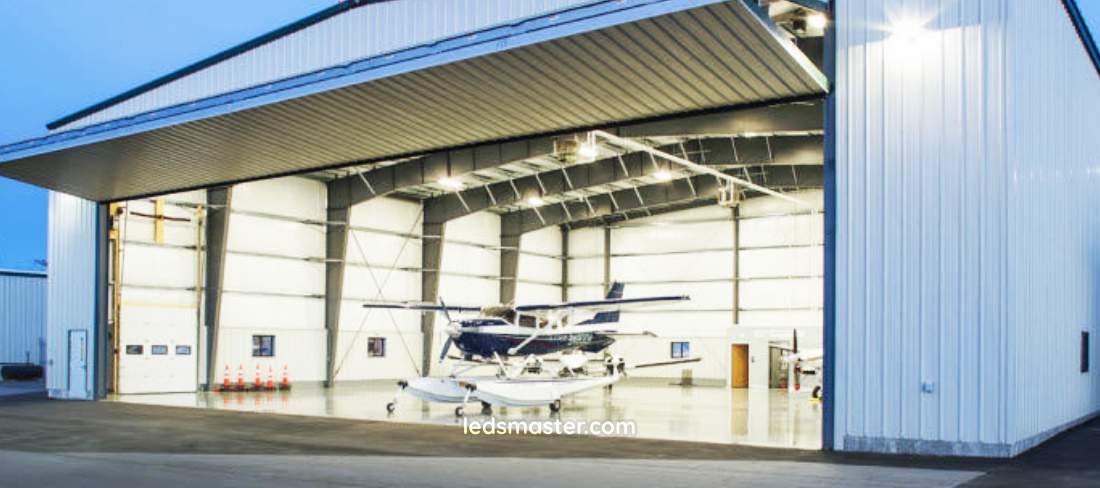
The right lighting design isn’t just about visibility—it’s about creating a space where maintenance, storage, and operations can happen smoothly and safely. Curious about how to achieve this ideal lighting setup? Let’s discover how to light up your hangar for maximum efficiency and performance!
Get your complimentary lighting design today
As expansive areas dedicated to the storage and upkeep of aircraft, hangars have unique lighting requirements compared to standard commercial or industrial facilities. Effective lighting design improves visibility during maintenance activities, enhances safety, and boosts overall operational performance. This article explores the fundamental elements of hangar lighting design, including key considerations, various lighting options, and best practices for achieving optimal illumination.
Table of Contents
ToggleThe primary function of hangar lighting is to provide adequate illumination for various activities, including aircraft maintenance, inspections, and storage. The lighting design must address the specific needs of the space, such as high-intensity lighting for detailed work and general illumination for larger areas. Additionally, different areas within a hangar may require different lighting levels. For example, maintenance bays may need brighter, focused lighting, while storage areas can be illuminated with less intense light.
Ensuring proper light levels and uniformity is essential for hangar lighting design. Adequate illumination is necessary to prevent accidents and facilitate precise work. The recommended light levels, measured in lux, vary depending on the area’s function. For detailed maintenance work, a minimum of 500 to 1000 lux is typically required, while general areas might need around 300 to 500 lux.
Uniformity in lighting helps eliminate shadows and reduces eye strain for workers. Poorly distributed light can lead to uneven illumination, creating areas of darkness or excessive brightness. Effective lighting design ensures that light is evenly spread across the hangar, reducing the risk of accidents and improving the quality of work performed.

Energy efficiency is a crucial consideration in hangar lighting design. Given the large size of hangars and their extensive lighting needs, energy consumption can be significant. Modern lighting technologies, such as LED, offer superior energy efficiency compared to traditional lighting solutions. LEDs consume less power, have longer lifespans, and require less maintenance, resulting in lower operational costs and a reduced environmental impact.
Sustainability is also a key concern. Implementing energy-efficient lighting solutions contributes to a facility’s overall sustainability goals. Additionally, incorporating features like motion sensors and dimming controls can further enhance energy savings by adjusting lighting levels based on occupancy and activity.
When designing lighting for hangars, controlling glare is a vital consideration to ensure visual comfort and safety for personnel. Glare occurs when overly bright or poorly placed light sources cause visual discomfort, reducing the ability to see clearly. In hangars, where workers may be engaged in detailed tasks such as aircraft inspections or maintenance, minimizing glare is essential to avoid eye strain and prevent accidents.
Several strategies can be employed to reduce glare in hangar lighting design. One effective method is to position light fixtures at appropriate angles to ensure that light is directed where it’s needed without creating harsh reflections or bright spots. Installing diffusers or using indirect lighting solutions can also help disperse light more evenly, reducing the intensity of direct beams that can lead to glare. Additionally, selecting lighting fixtures with proper shielding can prevent light from spilling into unintended areas, enhancing visual comfort across the workspace.
The color temperature and Color Rendering Index (CRI) of lighting play a significant role in hangar environments, especially where precise visual tasks are performed, such as maintenance and inspections. Color temperature, measured in Kelvin (K), refers to the appearance of the light—ranging from warm (yellowish) to cool (bluish) tones. For hangars, a neutral to cool white light, typically between 4000K and 6000K, is ideal. This range provides sufficient brightness and enhances visibility, helping workers differentiate between colors and details critical for aircraft servicing.
The Color Rendering Index (CRI) measures the accuracy with which a light source reveals the true colors of objects compared to natural sunlight. A higher CRI is crucial in hangars where accurate color perception is necessary, particularly for inspecting aircraft parts, paintwork, and electrical components. Lighting with a CRI of 80 or above is recommended to ensure that workers can accurately assess materials and perform quality checks without color distortion.

High-Intensity Discharge (HID) lighting, including metal halide and high-pressure sodium lamps, has been commonly used in hangars due to its high output and long reach. Metal halide lamps provide bright, white light that is suitable for detailed work and maintenance tasks. However, HID lamps have some drawbacks, such as longer warm-up times and reduced energy efficiency compared to modern technologies.
High-pressure sodium lamps offer a warm light that is effective for general illumination but may not provide the clarity needed for detailed work. While HID lighting can still be found in some hangars, its use is declining as more energy-efficient and advanced lighting options become available.
Fluorescent lighting is another option for hangar illumination, offering better energy efficiency and color rendering compared to HID lamps. Fluorescent lights provide a cool, white light that enhances visibility and reduces shadows. They are often used in conjunction with other lighting types to achieve a balanced illumination level.
Despite their advantages, fluorescent lights have some limitations, including the need for frequent bulb replacements and sensitivity to temperature fluctuations. In cold environments, fluorescent lights can become less effective and may require additional heating to maintain performance.
LED (Light Emitting Diode) lighting has emerged as the preferred choice for hangar lighting due to its numerous benefits. LEDs offer high energy efficiency, long lifespans, and excellent color rendering, making them ideal for both general and task-specific lighting in hangars. They provide bright, uniform light with minimal heat emission, reducing the risk of heat-related issues in sensitive areas.
LEDs are also highly versatile and can be configured in various ways to meet different lighting needs. For example, LED high-bay lights are well-suited for large hangars, offering powerful illumination and wide coverage. Additionally, LED lights can be equipped with smart controls, such as motion sensors and dimmers, to further enhance energy efficiency and functionality.
Incorporating smart lighting controls into the hangar lighting design can greatly improve efficiency and convenience. Smart controls allow for automated adjustments to lighting levels based on occupancy, time of day, or specific tasks. Motion sensors can automatically turn lights on or off based on movement, while dimmers can adjust brightness levels as needed.
Integration with building management systems (BMS) allows for centralized control and monitoring of the lighting system. This enables facility managers to optimize lighting conditions, track energy usage, and make real-time adjustments to improve efficiency and reduce costs.
Hangar lighting design is a critical aspect of creating a functional and efficient workspace. By carefully considering lighting needs, selecting appropriate technologies, and implementing best practices for installation and maintenance, facility managers can ensure optimal illumination for aircraft maintenance, inspections, and storage. Modern lighting solutions, particularly LEDs, offer significant advantages in terms of energy efficiency, performance, and sustainability. Investing in a well-designed lighting system not only enhances safety and operational efficiency but also contributes to long-term cost savings and environmental sustainability.